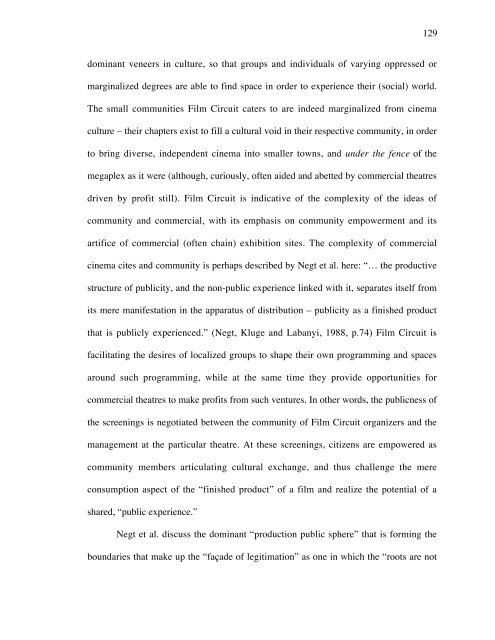The Spaces Between Grassroots Documentary ... - Ezra Winton
The Spaces Between Grassroots Documentary ... - Ezra Winton
The Spaces Between Grassroots Documentary ... - Ezra Winton
Create successful ePaper yourself
Turn your PDF publications into a flip-book with our unique Google optimized e-Paper software.
dominant veneers in culture, so that groups and individuals of varying oppressed or<br />
marginalized degrees are able to find space in order to experience their (social) world.<br />
<strong>The</strong> small communities Film Circuit caters to are indeed marginalized from cinema<br />
culture – their chapters exist to fill a cultural void in their respective community, in order<br />
to bring diverse, independent cinema into smaller towns, and under the fence of the<br />
megaplex as it were (although, curiously, often aided and abetted by commercial theatres<br />
driven by profit still). Film Circuit is indicative of the complexity of the ideas of<br />
community and commercial, with its emphasis on community empowerment and its<br />
artifice of commercial (often chain) exhibition sites. <strong>The</strong> complexity of commercial<br />
cinema cites and community is perhaps described by Negt et al. here: “… the productive<br />
structure of publicity, and the non-public experience linked with it, separates itself from<br />
its mere manifestation in the apparatus of distribution – publicity as a finished product<br />
that is publicly experienced.” (Negt, Kluge and Labanyi, 1988, p.74) Film Circuit is<br />
facilitating the desires of localized groups to shape their own programming and spaces<br />
around such programming, while at the same time they provide opportunities for<br />
commercial theatres to make profits from such ventures. In other words, the publicness of<br />
the screenings is negotiated between the community of Film Circuit organizers and the<br />
management at the particular theatre. At these screenings, citizens are empowered as<br />
community members articulating cultural exchange, and thus challenge the mere<br />
consumption aspect of the “finished product” of a film and realize the potential of a<br />
shared, “public experience.”<br />
Negt et al. discuss the dominant “production public sphere” that is forming the<br />
boundaries that make up the “façade of legitimation” as one in which the “roots are not<br />
129


